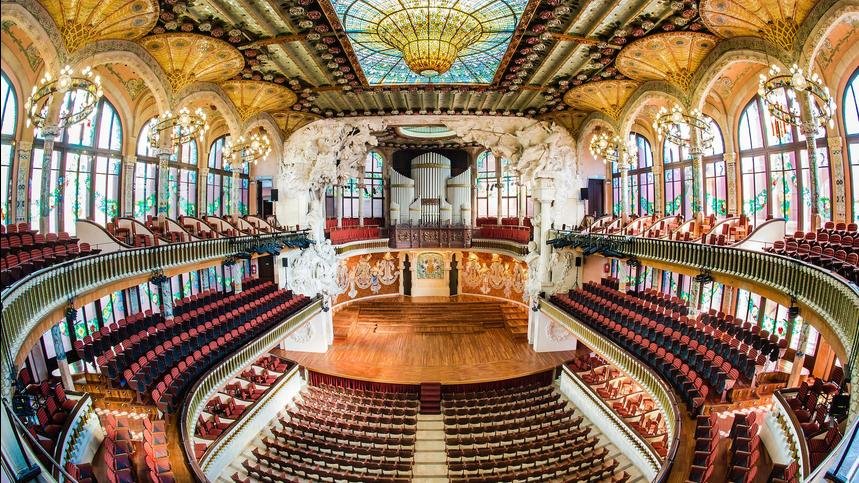Barcelona's Best Modernista Marvels
Modernisme, not to be misled with Modernism, was the combined name given to an art, architecture and literature movement which emerged around the turn of the 20th century and centralized around Barcelona.
The movement comparable with the Art Nouveau style taking place in France and also Belgium around the same time. Modernista construction style can be identified by its use of arcs rather than straight lines, elaborate decorations, vibrant use of colors and flower motifs. Famous Modernista architects include Antoni Gaudí, Lluís Domènech i Montaner and Josep Puig i Cadafalch. Listed below are some of the movement's most phenomenal buildings.
Palau de la Música Catalana
Palau de la Música Catalana
This UNESCO World Heritage concert hall was designed by designer Lluís Domènech i Montaner and is one of the most impressive Modernista buildings in the city, both inside and out. Constructed between 1905 and 1908, the Palau de la Música comprises a core metal structure covered in glass, in order to let natural light into the venue itself. From the outdoor, you'll see the royal residence's impressive rose-colored façade, accentuated with floral mosaic columns, stone sculptures and the busts of many famous composers such as Bach and Beethoven. Inside, however, is just as impressive, with stained glass windows along with ceilings, rock sculpted staircases and functioned iron lamps, each element developed by famous artists within the Modernista movement. This is the best example that how rich the paintings in Barcelona are. Visit the inside either on an assisted excursion or by purchasing tickets to one of the regular performances held here.
Hospital de la Santa Creu I Sant Pau
Hospital de la Santa Creu I Sant Pau
The biggest Modernista facility in the world, this is not your average healthcare facility. Once again, developed by Lluís Domènech I Montaner, it was constructed in between 1901 and 1930 as a collection of gardens along with pavilions in which to recover the sick. Having recently just reopened to people in 2014, today visitors can tour the premises, admiring its distinct buildings, full of designed tiles, vibrant mosaics, and colorful stained glass windows.
Casa Batlló
One of Antoni Guadí's most legendary and celebrated structures, Casa Batlló sits along the sophisticated Passeig de Gràcia. Renovated from a formerly existing residence in between 1904 and 1906, its undulating, iridescent blue along with green front is quite a sight to behold. Covered in mosaic ceramic tiles together with stained glass windows, the structure is capped by a ridge of scales and a single turret with a cross, said to represent the sword of Saint George (patron saint of Catalonia), being plunged into the back of the dragon. Inside, visitors can see the magnificent Noble Flooring (where the Batlló family lived), the outstanding stairwell as well as the roof terrace, decorated with four whimsical chimney stacks.
Casa Amatller
Casa Amatller
Standing next to Casa Batlló, Casa Amatller is sometimes eclipsed by its bystander. However, with its Dutch-style façade, bold delicious chocolate patterns, and ornate windows, it's difficult to overlook. Made by Josep Puig I Cadafalch-- a contemporary of Gaudí's-- it was likewise restored from an older structure and revamped between 1898 and 1900. Both on the outside and the inside, the building includes work by some of the finest Modernista sculptors together with artists, including Eusebi Arnau and Alfons Juyol.
Casa Fuster
Casa Fuster
Currently a luxury top-notch hotel sitting on top of Passeig de Gràcia, Casa Fuster was architect Lluís Domènech i Montaner's last creation in Barcelona and was developed between 1908 and 1911. Considered to be one of one of the most expensive edifices in the city, it's decorated with white marble ceramic tiles, lots of functioned iron balconies, slate and ornate pebble carvings. The architecture was a gift from the Mallorca aristocrat Mariano Fuster to his spouse Consol Fabra and still exhibits her initials on the side.
Casa de Les Punxes
Casa de Les Punxes
Having just opened up for people in 2016 for the first time in 100 years, Casa de les Punxes ('House of Spikes') is an important symbol of the city. The building started off as 3 detached residential properties, possessed by the Terradas sisters, who chose to ask architect Josep Puig I Cadafalch to refurbish the buildings and join them all together. The result was a Modernista twist on a medieval Gothic-style castle, crowned with fairytale turrets. Both on the in and out, the house is filled with aesthetic components such as stained glass windows, wrought iron arts, as well as sculptures, designed by widely recognized Catalan artists and craftsmen such as Enric Monserdà and Alfons Juyol.





